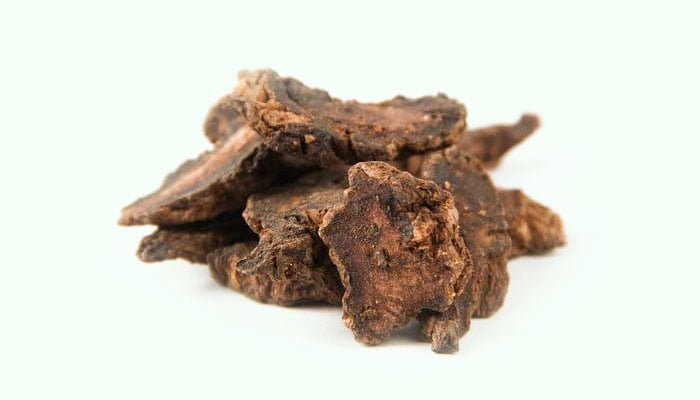What Is Sheng Di Huang
Sheng Di Huang also known as Radix Rehmanniae or Chinese Foxglove Root is the tuberous root of Rehmannia glutinosa, which is a perennial herb belonging to the family Scrophulariaceae. It is a relatively practical and common Chinese herbal medicine with a medicinal history of over 2,000 years.
There are 6 species of Rehmannia. The most representative one is Rehmannia glutinosa. This plant often grows on hillsides or roadside wastelands at an altitude of 50-1100 meters and has been planted. It is distributed in China, Japan, and North Korea.
The main producing area of Rehmannia glutinosa is in northern China, but it is the most famous one produced in Huai Qing Fu (Jiaozuo). It is defined by the Chinese as Si Da Huai Yao (four famous medicines from Huaiqing), and the other three are Shan Yao (Rhizoma Dioscoreae), Niu Xi (Radix Achyranthis Bidentatae), and Ju Hua (Flos Chrysanthemi).

In the traditional textile industry, it is used to make yellow dyes. Some products containing Sheng Di Huang are very popular in Southeast Asia.
It was introduced to Asian and European countries through the Silk Road in the Tang and Song Dynasties. Later, Zheng He brought it to Southeast Asia, the Middle East, and Africa. It was mentioned by <Dream of the Red Chamber>, which is one of China’s Four Great Classical Novels.
In the autumn of each year, people gather the roots of Rehmannia glutinosa, remove their fibrous roots, wash them with water, use them directly or dry them, and make them into Chinese herbal medicines.
Sheng Di Huang contains catalpol, dihydrocatalpol, leonuride, aucubin, danmelittoside, geniposide, rehmannioside, stachyose, raffinose, glucose, sucrose, fructose, mannotriose, verbascose, galactose, glutamic acid, arginine, aspartic acid, lysine, leucine, fatty acids, aromatic acids, β-sitosterol, succinic acid, daucosterol, flavonoids, phenolic acids, lignans, Fe, Mg, Cu, Ca, Zn, Cr, Mo, K, and other trace elements.
Generally, the solid Sheng Di Huang with a shiny, sticky, jet-black or brown-black cross-section is preferred.
According to the Chinese Pharmacopoeia, the medicinal nature of Sheng Di Huang is relatively cold, with a sweet and bitter taste. It has a certain therapeutic effect on the pathological changes of the heart, liver, and kidney meridians.
In traditional Chinese medicine, Sheng Di Huang is often used to clear heat and cool blood, nourish yin and promote fluid production, and treat primary thrombocytopenic purpura, functional uterine bleeding, lupus erythematosus, viral myocarditis, rheumatoid arthritis, Sheehan syndrome, eczema, neurodermatitis, urticaria, constipation, infectious hepatitis, diabetic neuropathy.
There are about 150 kinds of Chinese medicine prescriptions containing Sheng Di Huang, such as Jiu Wei Qiang Huo Tang, Qing Ying Tang, and Tian Ma Wan.
Benefits
- Inhibiting lipid peroxidation and delaying aging.
- Reducing the alcohol-induced gastric mucosal damage and protecting the gastric mucosa.
- Reducing the damage of CCL4 to liver tissue and protecting the liver.
- Lowering blood sugar and blood lipids, preventing type 2 diabetes.
- Relieving neuropathic pain and having cardiotonic and diuretic effects.
- Promoting the proliferation of osteoblasts, increasing the activity of osteoblasts alkaline phosphatase, and preventing osteoporosis.
- Improving the spleen index and thymus index, promoting the proliferation of T lymphocytes, enhancing the phagocytic ability of macrophages, and improving immunity.
- Dilating blood vessels, reducing the permeability of capillaries, inhibiting inflammation of vascular endothelium and experimental joint synovial swelling in rats.
- Antagonizing the decrease of plasma corticosterone concentration caused by continuous administration of dexamethasone, and preventing adrenal cortex atrophy.
- Improving the learning and memory ability of experimental mice induced by D-galactose or AlCl3.
- Inducing the apoptosis of HepG-2 cells, SGC-7901 tumor cells, and SH-SY5Y cells.
- Clearing heat, treating polydipsia, loss of consciousness, delirium, and deep-red tongue caused by the invasion of ying and xue systems by heat.
- Cooling blood, treating nosebleeds, hematochezia, hematuria, postpartum hemorrhage, metrorrhagia caused by blood heat.
- Removing heat toxins, treating crimson macules and papules caused by heat toxins.
- Nourishing yin, relieving hot flashes, and internal heat due to yin deficiency.
- Treating febrile diseases in the late stage with manifestations such as fever at night, no sweating, and reddish tongue.
- Promoting fluid production, treating polydipsia caused by yin impairment in febrile diseases.
- Treating high blood sugar and urine sugar caused by internal heat due to yin deficiency.
- Moistening the intestines and treating constipation caused by intestinal dryness.
Combinations
- It can be used in combination with Di Yu (Radix Sanguisorbae), etc. to treat hematochezia and hematuria caused by blood heat.
- It can be used in combination with Mai Dong (Radix Ophiopogonis), Nan Sha Shen (Radix Adenophorae), Yu Zhu (Rhizoma Polygonati Odorati), etc. to treat polydipsia caused by yin impairment in febrile diseases.
- It can be used in combination with Shan Yao (Rhizoma Dioscoreae), Huang Qi (Radix Astragali), Shan Zhu Yu (Fructus Corni), etc. to treat high blood sugar and urine sugar caused by internal heat.
- It can be used in combination with Huang Qin (Radix Scutellariae), Ku Shen (Radix Sophorae Flavescentis), etc. to treat lupus erythematosus.
- It can be used in combination with Lian Qiao (Fructus Forsythiae), Huang Qin (Radix Scutellariae), Mai Dong (Radix Ophiopogonis), Xuan Shen (Radix Scrophulariae), etc. to treat diphtheria.
Side Effects
- At present, there is no literature report that Sheng Di Huang has toxic effects, and there is no data showing that taking it will cause serious adverse reactions.
Precautions and Warnings
- The dosage of Sheng Di Huang should be controlled between 10-15g.
- When using fresh Sheng Di Huang, the dose should be doubled.
- It can be made into decoctions, pills, powders, or injections.
- It is not recommended to use iron utensils to boil it.
- It should not be taken with radish, green onion, fritillaria, or turnips.
- People who are allergic to Sheng Di Huang should not take it.
- Patients with a deficiency of spleen-qi should not take it.
- Patients with poor appetite should not take it.
- Patients with loose stools should not take it.
